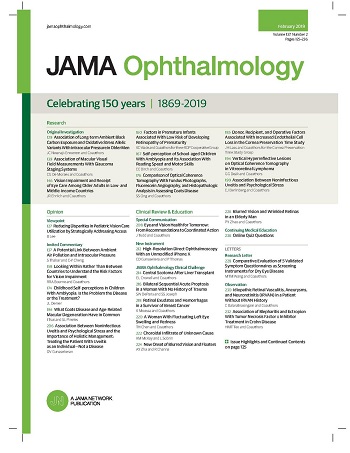Primary Open-Angle Glaucoma Polygenic Risk Score and Risk of Disease Onset
IF 7.8
1区 医学
Q1 OPHTHALMOLOGY
引用次数: 0
Abstract
ImportancePrimary open-angle glaucoma (POAG) is a heritable disease. A polygenic risk score (PRS) threshold may be used to identify individuals at low risk of disease onset.ObjectiveTo assess the utility of a POAG PRS to identify ocular hypertensive individuals at low risk of disease onset.Design, Setting, and ParticipantsThis is a post hoc analysis of the Ocular Hypertension Treatment Study (OHTS), a multicenter randomized clinical trial across 22 centers in the US conducted among 1636 participants with ocular hypertension from February 1994 to April 2019 with available genetic data. Of the 1636 original participants, 1077 had available genetic data; after excluding 67 for missing data, data quality concerns, or ancestry other than European or African, 1010 were included in the present analysis. Data for this report were analyzed from November 2023 to June 2024.ExposureFrom 1994-2002, participants were randomized to receive topical intraocular pressure (IOP)–lowering medications. From 2002 onwards, all participants were given topical IOP-lowering medications.Main Outcome and MeasureTwenty-year conversion rates by POAG PRS threshold, baseline randomization status, and OHTS clinical risk tertile.ResultsAmong the 1010 participants in this study, 563 (65.8%) were female, and the mean (SD) age was 55.9 (9.4) years. In a mixed-effects logistic regression model adjusted for OHTS risk factors for conversion to POAG and randomization status, a PRS under the 48th percentile was associated with a 1.49 times higher likelihood of disease-free status after 20 years of follow-up (95% CI, 1.04-2.15;原发性开角型青光眼多基因风险评分与发病风险
重要性原发性开角型青光眼(POAG)是一种遗传性疾病。目的评估 POAG PRS 在识别发病风险较低的眼压高患者方面的实用性。设计、设置和参与者这是对眼压高治疗研究(OHTS)的一项事后分析,该研究是美国 22 个中心的一项多中心随机临床试验,从 1994 年 2 月至 2019 年 4 月在 1636 名有遗传数据的眼压高患者中进行。在 1636 名原始参与者中,1077 人有可用的基因数据;因数据缺失、数据质量问题或血统非欧洲人或非洲人而排除 67 人后,1010 人被纳入本分析。本报告的数据分析时间为 2023 年 11 月至 2024 年 6 月。从 1994 年到 2002 年,参与者被随机分配接受局部降眼压药物治疗。主要结果和测量按POAG PRS阈值、基线随机化状态和OHTS临床风险三分位数划分的20年转换率。结果在这项研究的1010名参与者中,563人(65.8%)为女性,平均(标清)年龄为55.9(9.4)岁。在调整了转为 POAG 的 OHTS 危险因素和随机状态的混合效应逻辑回归模型中,与高多基因风险相比,PRS 低于第 48 百分位数与随访 20 年后无病的可能性高 1.49 倍相关(95% CI,1.04-2.15;P = .03;未调整危险比 [HR],1.64;95% CI,1.13-2.38;P = .009)。当我们将试验队列分为非遗传性 OHTS 临床风险三等分时,根据 PRS 临界值,最高三等分初始观察组的眼睛 20 年存活概率差异最大(20 年转换率:高多基因风险组为 61.1%;低多基因风险组为 61.1%):高多基因风险组为 61.1%,低多基因风险组为 23.8%;95% CI,-63.0 至 -11.6;P = .01),随机进行早期治疗部分缓解了高遗传风险的影响(20 年转阴率:高多基因风险组为 37.3%,低多基因风险组为 23.8%;95% CI,-63.0 至 -11.6;P = .01):结论和相关性这些研究结果支持考虑使用 POAG PRS 阈值来识别发病风险较低的个体,PRS 阈值以下的个体在 20 年内的转化率较低。在基于 OHTS 临床风险模型的高风险人群中,早期治疗可部分抵消与高遗传风险的关联,但对低遗传风险人群的益处有限:NCT00000125
本文章由计算机程序翻译,如有差异,请以英文原文为准。
求助全文
约1分钟内获得全文
求助全文
来源期刊

JAMA ophthalmology
OPHTHALMOLOGY-
CiteScore
13.20
自引率
3.70%
发文量
340
期刊介绍:
JAMA Ophthalmology, with a rich history of continuous publication since 1869, stands as a distinguished international, peer-reviewed journal dedicated to ophthalmology and visual science. In 2019, the journal proudly commemorated 150 years of uninterrupted service to the field. As a member of the esteemed JAMA Network, a consortium renowned for its peer-reviewed general medical and specialty publications, JAMA Ophthalmology upholds the highest standards of excellence in disseminating cutting-edge research and insights. Join us in celebrating our legacy and advancing the frontiers of ophthalmology and visual science.
 求助内容:
求助内容: 应助结果提醒方式:
应助结果提醒方式:


